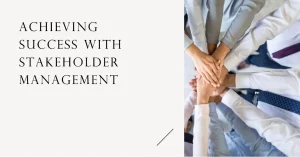Introduction
Particularly within research environments, the role of a research project manager is pivotal. A research project manager is responsible for overseeing the planning, execution, and delivery of research projects, ensuring that objectives are met within the defined constraints of time, budget, and resources. This role requires a deep understanding of the project’s goals, risks, and the dynamics of team collaboration.
The significance of effective teams in research projects cannot be overstated. High-performing research teams are essential for driving innovation, meeting deadlines, and achieving project goals. They leverage diverse skills and perspectives, fostering an environment where creativity and problem-solving thrive. Research has shown that teams that communicate effectively and establish clear objectives are more likely to succeed, as they can navigate challenges and adapt to changing circumstances with agility [1][13].
This blog post will explore various strategies for assembling and leading effective research teams. We will delve into the importance of setting clear goals, fostering collaboration, and building trust among team members. Additionally, we will discuss practical techniques for enhancing team performance and maintaining alignment with project objectives. By the end of this post, research project managers and team leaders will have actionable insights to cultivate high-performing teams that can drive their research initiatives to success.
Understanding Team Dynamics in Research Projects
Understanding team dynamics is crucial for achieving successful outcomes. Research project managers and team leaders face unique challenges that can significantly impact the effectiveness of their teams. Here are some key points to consider:
Unique Challenges Faced by Research Teams
Research teams often operate in complex and dynamic environments where uncertainty is prevalent. Some of the challenges they encounter include:
- Interdisciplinary Collaboration: Research projects frequently require collaboration among individuals with diverse expertise. This can lead to communication barriers and misunderstandings if not managed effectively [10].
- Resource Constraints: Limited budgets and timeframes can hinder the ability to conduct thorough research, necessitating efficient use of available resources [10].
- Evolving Objectives: Research goals may shift as new findings emerge, requiring teams to adapt quickly and remain flexible in their approach [10].
Significance of Diverse Skill Sets and Perspectives
Diversity within research teams is not just beneficial; it is essential for fostering innovation and creativity. The inclusion of varied skill sets and perspectives can lead to:
- Enhanced Problem-Solving: Teams composed of members with different backgrounds can approach challenges from multiple angles, leading to more comprehensive solutions [12].
- Increased Creativity: A mix of perspectives encourages brainstorming and the generation of novel ideas, which is vital in research settings where traditional methods may not suffice [12].
- Broader Understanding: Diverse teams can better understand and address the needs of various stakeholders, ensuring that research outcomes are relevant and impactful [12].
Importance of Establishing a Collaborative Culture
Creating a collaborative culture is fundamental to the success of research teams. This involves:
- Open Communication: Encouraging team members to share ideas and feedback fosters an environment of trust and respect, which is essential for collaboration [7].
- Shared Goals: Establishing clear, common objectives helps align team efforts and ensures that everyone is working towards the same outcomes [9].
- Recognition and Support: Implementing recognition programs that celebrate team achievements can enhance motivation and reinforce a sense of belonging among team members [2].
Identifying the Right Team Members
Assembling a high-performing research project team is crucial for the success of any research initiative. The selection of team members should be a strategic process that considers various criteria to ensure that the team is well-equipped to meet project objectives. Here are some key strategies for identifying the right team members:
Criteria for Selecting Team Members
Expertise and Experience:
- Assess the specific skills and expertise required for the project. This involves a thorough understanding of the project scope and the tasks that need to be accomplished. Team members should possess relevant technical knowledge and experience that align with the project’s goals [5].
- Look for individuals who have a proven track record in similar research projects or fields. Their past experiences can provide valuable insights and enhance the team’s overall capability [1].
Soft Skills:
- In addition to technical skills, interpersonal skills are vital. Team members should be excellent communicators, able to articulate ideas clearly and collaborate effectively with others [10].
- Organizational skills and self-discipline are also important attributes. A well-organized team member can help maintain project timelines and ensure that tasks are completed efficiently [10].
The Role of Interdisciplinary Collaboration
Interdisciplinary collaboration is essential in research projects, as it brings together diverse perspectives and expertise. This diversity can lead to innovative solutions and a more comprehensive understanding of complex problems. When selecting team members, consider individuals from various disciplines who can contribute unique insights and approaches to the research [12]. This not only enhances creativity but also fosters a collaborative environment where team members can learn from one another.
Techniques for Assessing Candidate Suitability
- Structured Interviews: Conduct structured interviews that focus on both technical competencies and soft skills. Prepare questions that assess candidates’ problem-solving abilities, teamwork experiences, and adaptability to changing project needs [7].
- Skill Assessments: Utilize practical assessments or case studies relevant to the project. This allows candidates to demonstrate their skills in real-world scenarios, providing a clearer picture of their capabilities [4].
- Reference Checks: Perform thorough reference checks to gain insights into candidates’ past performance and work ethic. Speaking with previous supervisors or colleagues can reveal important information about a candidate’s suitability for the team [12].
- Team Fit Evaluation: Consider conducting team fit evaluations where potential team members interact with existing team members. This can help assess how well they align with the team’s culture and dynamics, which is crucial for fostering a collaborative environment [9].
By carefully considering these criteria and employing effective assessment techniques, research project managers can build a high-performing team that is well-equipped to tackle the challenges of their projects. The right mix of expertise, experience, and interpersonal skills will not only enhance project outcomes but also contribute to a positive and productive team environment.
Establishing Clear Roles and Responsibilities
Establishing clear roles and responsibilities is paramount for fostering a high-performing team. When team members have a well-defined understanding of their roles, it not only enhances individual performance but also contributes to the overall success of the project. Here are some key points to consider:
Benefits of Clarity in Roles for Team Performance
- Improved Productivity: Clearly defined roles reduce confusion and overlap, allowing team members to focus on their specific tasks. This clarity leads to more efficient task completion and higher productivity, as employees know exactly what is expected of them [11].
- Enhanced Collaboration: When team members understand their responsibilities, they can collaborate more effectively. This understanding fosters a culture of accountability and encourages open communication, which is essential for problem-solving and innovation [10].
- Reduced Conflict: Clarity in roles minimizes misunderstandings and conflicts among team members. When everyone knows their responsibilities, the likelihood of disputes over task ownership decreases, leading to a more harmonious working environment [3].
Methods for Defining Roles Based on Project Needs
- Align with Project Objectives: Before defining roles, it is crucial to align the team’s strategy with the project’s objectives. This ensures that each role directly supports the overarching goals of the research project, preventing misdirected efforts [14].
- Assess Team Strengths: Understanding the strengths and weaknesses of team members is vital. Assigning roles based on individual skills and expertise not only enhances performance but also boosts team morale, as members feel valued for their contributions [15].
- Regular Reviews and Updates: Roles and responsibilities should not be static. Regularly reviewing and updating them as the project evolves ensures that they remain relevant and aligned with changing project needs [12].
Using RACI Matrices to Clarify Responsibilities
A RACI matrix is a powerful tool for clarifying roles and responsibilities within a research project team. RACI stands for Responsible, Accountable, Consulted, and Informed, and it helps in delineating who is responsible for what tasks. Here’s how to effectively implement a RACI matrix:
- Define Tasks and Deliverables: Start by listing all the key tasks and deliverables of the project. This provides a comprehensive overview of what needs to be accomplished [8].
- Assign Roles: For each task, assign roles using the RACI framework:
- Responsible: Who is responsible for executing the task?
- Accountable: Who is ultimately accountable for the task’s success?
- Consulted: Who needs to be consulted for input or expertise?
- Informed: Who needs to be kept informed about progress and decisions?
- Communicate the Matrix: Share the RACI matrix with the entire team to ensure everyone understands their roles and responsibilities. This transparency fosters accountability and encourages team members to take ownership of their tasks [10].
Fostering Effective Communication
Effective communication is a cornerstone of successful research project management. It not only enhances collaboration but also ensures that all team members are aligned with the project goals. Here are some strategies to foster effective communication within your research project teams:
1. Setting Up Clear Communication Channels
Establishing well-defined communication channels is essential for ensuring that information flows smoothly among team members. This can include:
- Regular Meetings: Schedule frequent touchpoints for team members to discuss progress, share concerns, and exchange ideas. This creates a structured environment for communication and helps in addressing issues promptly [4].
- Communication Plans: Develop detailed communication plans that outline how information will be shared, who is responsible for updates, and the frequency of communication. This is particularly valuable in complex projects with multiple stakeholders [9].
- Protocols for Information Sharing: Create clear protocols for how information is disseminated within the team. This can help prevent misunderstandings and ensure that everyone has access to the necessary information [8].
2. Encouraging Open Feedback and Dialogue
Promoting a culture of open feedback and dialogue is crucial for team cohesion and innovation. Here are some techniques to encourage this:
- Mindfulness Practices: Encourage team members to practice mindfulness and be transparent in their communications. This can help in creating an environment where individuals feel safe to express their thoughts and concerns [3].
- Feedback Mechanisms: Implement regular feedback sessions where team members can share their insights and suggestions. This not only fosters a sense of ownership but also helps in identifying areas for improvement [11].
- Active Listening: Train team members in active listening techniques to ensure that everyone feels heard and valued. This can enhance trust and collaboration within the team [15].
3. Utilizing Technology to Facilitate Remote Communication
In today’s digital age, leveraging technology is vital for maintaining effective communication, especially in remote or hybrid work environments. Consider the following:
- Collaboration Tools: Utilize platforms such as Slack, Microsoft Teams, or Asana to facilitate real-time communication and project management. These tools can help keep everyone on the same page and streamline information sharing [7].
- Video Conferencing: Regular video calls can help maintain personal connections among team members, making it easier to discuss complex topics and foster a sense of community [12].
- Document Sharing: Use cloud-based document sharing services to ensure that all team members have access to the latest project documents and updates. This can reduce confusion and enhance collaboration [10].
By implementing these strategies, research project managers can create an environment that promotes effective communication, ultimately leading to a high-performing research project team. Prioritizing communication not only enhances team dynamics but also drives project success by fostering trust, collaboration, and innovation [2][6].
Setting Goals and Milestones
Establishing clear goals and milestones is crucial for guiding teams toward successful outcomes. Here are some strategies and techniques to effectively set goals and milestones for your research projects:
Establishing SMART Goals
Setting SMART goals—Specific, Measurable, Achievable, Relevant, and Time-bound—provides a structured framework for defining objectives in research projects. This approach ensures that:
- Specific: Goals should be clear and unambiguous, detailing exactly what is to be achieved. For instance, instead of stating “improve research quality,” specify “increase the accuracy of data collection by 20% within six months” [14].
- Measurable: Incorporate metrics to assess progress. This could involve quantifying results or using qualitative assessments to gauge improvements [15].
- Achievable: Goals should be realistic and attainable, considering the resources and time available. This helps maintain team motivation and focus [14].
- Relevant: Ensure that the goals align with broader project objectives and the overall vision of the research initiative. This alignment fosters a sense of purpose among team members [10].
- Time-bound: Set deadlines for each goal to create a sense of urgency and facilitate timely progress reviews [10].
Aligning Team Goals with Project Objectives
It is essential to ensure that individual and team goals are aligned with the overarching project objectives. This alignment can be achieved by:
- Involving Stakeholders: Engage team members and stakeholders in the goal-setting process to ensure that everyone understands the project’s vision and their role in achieving it [11].
- Regular Communication: Maintain open lines of communication to discuss how individual contributions support the project’s objectives. This helps reinforce the importance of each team member’s work and encourages collaboration [7].
- Adjusting Goals as Needed: Be flexible and willing to adjust goals based on project developments or feedback from team members. This adaptability can enhance team morale and commitment to the project [8].
Tracking Progress Through Milestones and Regular Reviews
Milestones serve as critical checkpoints in the research project timeline, allowing teams to monitor progress and make necessary adjustments. To effectively track progress:
- Define Clear Milestones: Break down the project into smaller, manageable sections with specific milestones that indicate when key tasks should be completed. This approach provides clarity on what needs to be done and by when [2].
- Utilize Project Management Tools: Implement project management software that allows for task management, milestone tracking, and visualization of project progress. This can help keep the team organized and focused on their objectives [4].
- Conduct Regular Reviews: Schedule periodic reviews to assess progress against milestones. These reviews should involve discussing achievements, identifying challenges, and recalibrating goals if necessary. Regular feedback loops help maintain momentum and keep stakeholders informed [7][11].
By implementing these strategies for setting goals and milestones, research project managers can build high-performing teams that are aligned, motivated, and focused on achieving their objectives. This structured approach not only enhances project efficiency but also fosters a collaborative environment where team members feel valued and engaged in the research process.
Monitoring Team Performance and Progress
Effectively monitoring team performance and progress is crucial for ensuring that projects meet their objectives and deadlines. Here are several strategies and techniques that research project managers can employ to assess performance throughout the project lifecycle:
Methods for Evaluating Individual and Team Performance
- Set Relevant Goals: Establishing clear, relevant goals is foundational for both individual and team performance. Research indicates that teams that set specific goals can experience a 20 to 25 percent improvement in work performance. Engaging with each team member to define these goals can foster a sense of ownership and accountability [1].
- Utilize Performance Metrics: Implementing performance metrics tailored to research projects is essential. Metrics can include productivity rates, adherence to timelines, and quality of outputs. These metrics provide quantifiable data that can help in assessing both individual contributions and overall team effectiveness [8].
- Earned Value Management (EVM): This quantitative technique integrates scope, time, and cost data to provide a comprehensive view of project performance. EVM is particularly beneficial in complex research projects, allowing managers to track progress against planned performance and make informed decisions [11].
Importance of Regular Check-Ins and Feedback Loops
- Conduct Regular Check-Ins: Frequent check-ins with team members are vital for addressing challenges as they arise. These meetings should focus on tracking progress rather than solely evaluating final outcomes. This proactive approach helps in identifying potential issues early and allows for timely interventions [2].
- Establish Feedback Loops: Creating a culture of continuous feedback is essential for team development. Encouraging team members to provide and receive feedback fosters an environment of open communication, which can lead to improved performance and morale. Listening to feedback and acting on it can significantly enhance team dynamics and project outcomes [3].
Utilizing Performance Metrics Relevant to Research Projects
- Track Key Performance Indicators (KPIs): Identifying and monitoring KPIs specific to research projects, such as publication rates, grant acquisition, and project milestones, can provide insights into team performance. Regularly reviewing these indicators helps in making data-driven adjustments to project plans [9].
- Monitor Progress Against Milestones: Keeping track of milestones on a daily, weekly, or monthly basis ensures that the team remains aligned with project goals. This practice not only helps in maintaining momentum but also allows for adjustments to be made if the team is falling behind schedule [12].
- Evaluate Team Capacity and Resource Allocation: Understanding the capacity of your team and ensuring that resources are allocated effectively is crucial. Regular assessments of team workload and project demands can help in optimizing performance and preventing burnout [4].
By implementing these strategies, research project managers can build high-performing teams that are well-equipped to navigate the complexities of research projects. Monitoring team performance and progress not only enhances project outcomes but also contributes to the professional growth of team members, ultimately leading to a more successful research environment.
Encouraging Professional Development
Fostering a culture of continuous learning and professional development is essential for building high-performing teams. Here are some strategies to effectively encourage professional growth within your research team:
- Identifying Training Needs: It is crucial to consult with team members to understand their developmental needs. This can be achieved through regular one-on-one meetings or surveys that assess their skills and areas for improvement. By identifying these training needs, project managers can tailor development programs that align with both individual aspirations and project goals, ensuring that team members are equipped with the necessary skills to excel in their roles [2][10].
- Creating Opportunities for Professional Growth: Establishing a learning culture within the team is vital. This can include promoting access to training programs, workshops, and conferences that keep team members updated on the latest trends and methodologies in research. Encouraging participation in interdisciplinary projects can also provide team members with diverse experiences and perspectives, enhancing their skill sets and fostering innovation [10][15]. Additionally, setting clear goals and expectations for professional development can motivate team members to pursue growth actively [3][8].
- Benefits of Mentorship and Knowledge Sharing: Implementing a mentorship program can significantly enhance professional development within research teams. Pairing less experienced team members with seasoned professionals allows for the transfer of knowledge and skills, fostering a supportive environment where learning is prioritized. This relationship not only aids in skill development but also boosts morale and team cohesion [11][15]. Furthermore, encouraging knowledge sharing through regular team meetings and collaborative platforms can facilitate open dialogue, allowing team members to learn from each other’s experiences and insights [1][10].
By prioritizing professional development, research project managers can cultivate a motivated and skilled team capable of tackling complex challenges and achieving project success. Continuous learning not only enhances individual capabilities but also contributes to the overall effectiveness and innovation of the research team.
Celebrating Success and Learning from Failures
Recognizing achievements and understanding setbacks are crucial for fostering a high-performing team. Celebrating successes not only boosts morale but also reinforces the behaviors and practices that lead to those achievements. Conversely, learning from failures is essential for continuous improvement and innovation. Here are some strategies to effectively celebrate milestones and cultivate a culture of reflection within your research team.
Ways to Celebrate Project Milestones and Successes
- Public Recognition: Acknowledge accomplishments during team meetings, in company newsletters, or on social media platforms. This not only highlights individual contributions but also fosters a sense of community and shared purpose among team members [13].
- Team Celebrations: Organize informal gatherings or team lunches to celebrate project completions or significant milestones. These events can strengthen team bonds and create a positive atmosphere that encourages collaboration [11].
- Awards and Incentives: Consider implementing a recognition program that rewards outstanding contributions. This could include certificates, small gifts, or even a “team member of the month” award, which can motivate team members to strive for excellence [13].
- Reflective Sessions: After achieving a significant milestone, hold a reflective session where team members can share their experiences and insights. This not only celebrates success but also encourages open communication and learning [14].
Fostering a Culture of Reflection and Learning from Failures
- Normalize Discussions About Failures: Create an environment where team members feel safe discussing setbacks without fear of blame. This psychological safety encourages openness and honesty, which are vital for learning [12].
- Post-Mortem Analyses: After project completion, conduct a thorough review of both successes and failures. Analyze what went well and what could be improved, and document these insights for future reference. This practice helps prevent the repetition of mistakes and enhances decision-making [7][10].
- Encourage Experimentation: Promote a culture where team members are encouraged to take calculated risks and experiment. When failures occur, frame them as learning opportunities rather than setbacks. This approach fosters innovation and resilience within the team [6][15].
- Incorporating Lessons Learned: Ensure that the lessons learned from previous projects are integrated into future planning and execution. This can be done through regular training sessions, updates to project management methodologies, or by maintaining a repository of insights that team members can access [2][10].
By celebrating successes and learning from failures, research project managers can build a resilient and high-performing team. Recognizing achievements reinforces positive behaviors, while a commitment to learning from setbacks fosters continuous improvement and innovation. Embracing both aspects is essential for the long-term success of any research project.
Conclusion
Assembling and leading a high-performing team is crucial for achieving innovative and impactful results. Throughout this blog, we have explored several key strategies that can significantly enhance the effectiveness of your research teams:
- Hiring the Right People: Selecting team members based not only on their skills but also on their work styles and reliability ensures a good fit for the project’s needs. This foundational step sets the stage for a cohesive team dynamic [2].
- Fostering Open Communication: High-performing teams thrive on open lines of communication, which facilitate trust and collaboration. Regular meetings and team-building exercises can help maintain this essential flow of information [4][13].
- Setting Clear Expectations: Establishing clear goals and expectations is vital for aligning the team’s efforts and maintaining focus on shared objectives. Leaders should work closely with team members to ensure everyone understands their roles and responsibilities [10][11].
- Encouraging Continuous Improvement: A commitment to ongoing development and adaptability is necessary for teams to navigate challenges effectively. This includes recognizing individual performance and fostering a culture of collaboration [8][14].
Find out more about Shaun Stoltz https://www.shaunstoltz.com/about/.
This post was written by an AI and reviewed/edited by a human.



